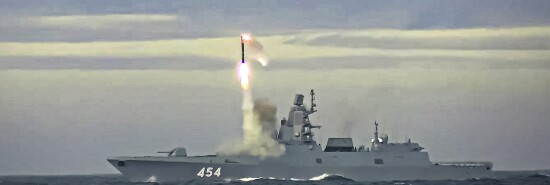
Assessing Russia’s Zircon missile threat in the Mediterranean Sea
Tom Rogan
Video Embed
With the West set to provide Ukraine with around 100 tanks, Russia faces yet another challenge in its struggling war in Ukraine. Attempting to alleviate this pressure, Vladimir Putin‘s government is escalating its brinkmanship. The Kremlin wants to scare European nations in pursuit of two objectives. First, their reduced support for Ukraine. Second, their pressuring of the U.S. to make Ukraine agree to a cease-fire on terms favorable to Russia.
Much of Russia’s pressure campaign centers on nuclear and rhetorical threats. Yet, befitting Russia’s penchant for creative aggression, the possibility of a different escalation strategy may arrive in the coming weeks.
100 TANKS WILL GO A LONG WAY FOR UKRAINE
In an interview with Moscow’s state-aligned Moskovskij Komsomolets newspaper on Wednesday, a naval reservist captain, Vladimir Gundarov, suggested that the Russian Navy’s Admiral Gorshkov frigate might deliver “a pleasant surprise for us and unpleasant for Europe and Ukraine.”
The lead ship in a new class of guided missile frigates, Admiral Gorshkov was deployed on a global cruise in early January. The warship is currently in the middle of the Atlantic Ocean conducting simulation tests of its Zircon hypersonic cruise missile system. It is being monitored by the U.S. Navy, possibly including the USS New Mexico attack submarine, which is operating in the Atlantic. Still, Gundarov noted that closest attention will be due when the ship turns east. As he put it, “our sailors in the Mediterranean Sea could well send Zircon to some objects on the territory of Ukraine. After all, we should test our new product in real work, right?”
The hint here is of a conventionally (non-nuclear) armed Zircon missile being fired at Ukraine. To be clear, this is likely Russian hyperbole designed to foster nationalist pride amid the embarrassment of Russia’s military struggles in Ukraine. Still, Gundarov’s threat can’t be written off entirely.
Considering the Zircon’s range is limited to approximately approximatly 756 miles (1,200 kilometers), Admiral Gorshkov would likely have to launch any missile against Ukraine from the Aegean Sea. Even then, its targeting options would be limited to south eastern and south central Ukrainian cities such as Odesa, Mykolaiv and Kherson.
That said, were Putin to desire new escalation, the prospective benefit of any such Zircon strike is clear. First, it would show that the missile works and that Russia’s defense industry retains some advanced skill. Moreover, the Zircon’s direct flight path from the Aegean Sea to Ukraine would see it overfly three NATO member states; Greece, Bulgaria and Romania. While a French MAMBA air defense system is operating in Romania, it is unlikely to be able to engage the Zircon in overflight.
CLICK HERE TO READ MORE FROM THE WASHINGTON EXAMINER
Putin might gamble that this action would spark division in NATO between states that wished to escalate in response to the Zircon overflight (such as the U.S., UK, Poland and the Baltics), and states in Western Europe (such as Germany, Italy and Belgium), that prefer appeasement. Russia’s hope would be to weaken NATO’s unified credibility and catalyze the fear of Western populations over the risk of uncontrolled escalation. Putin would then hope to use this to pressure the West into reducing its support for Ukraine.
Again, this is probably just a Russian propaganda bluff for domestic consumption. But it underlines why NATO will keep a close eye on Admiral Gorshkov until it returns to port.
